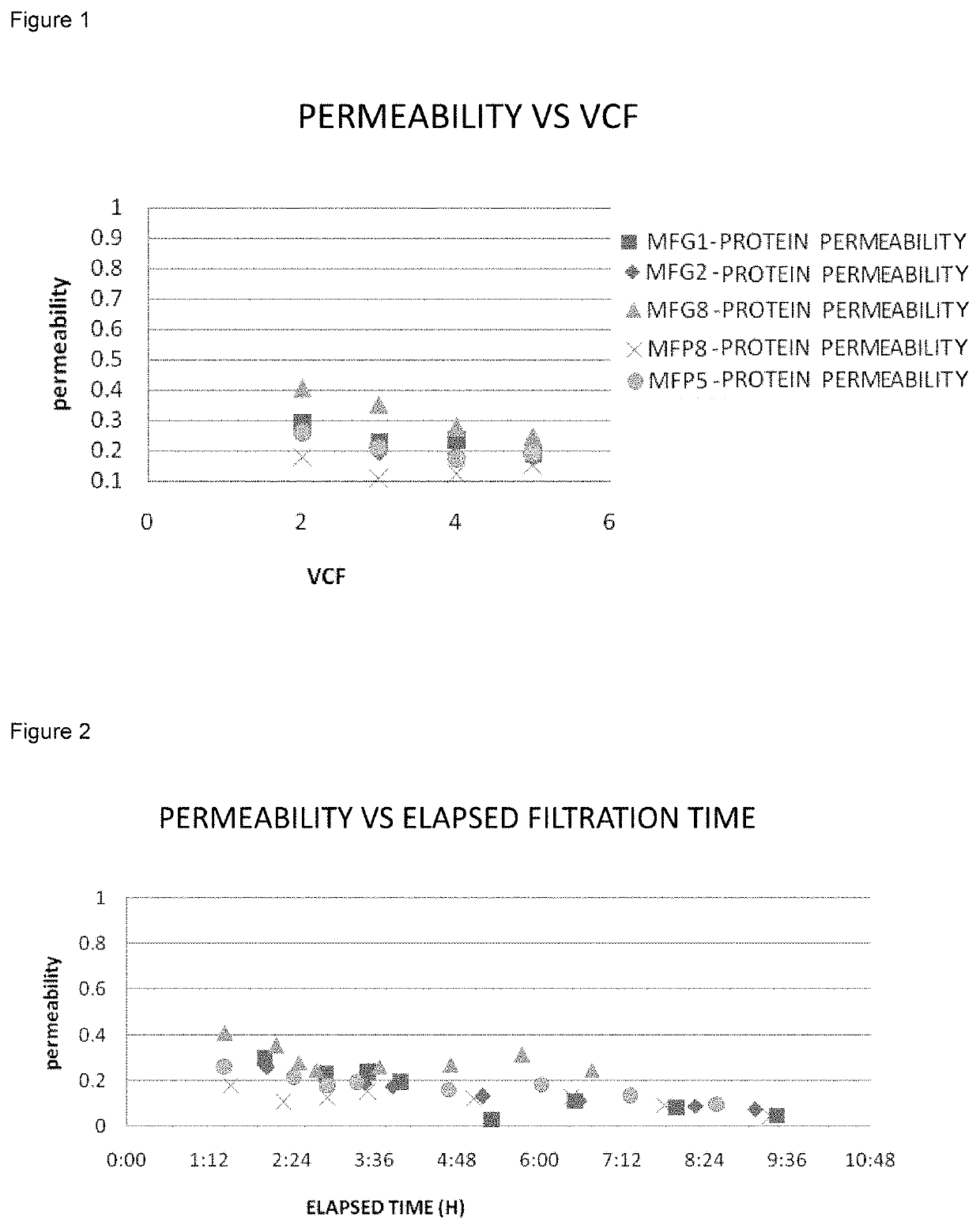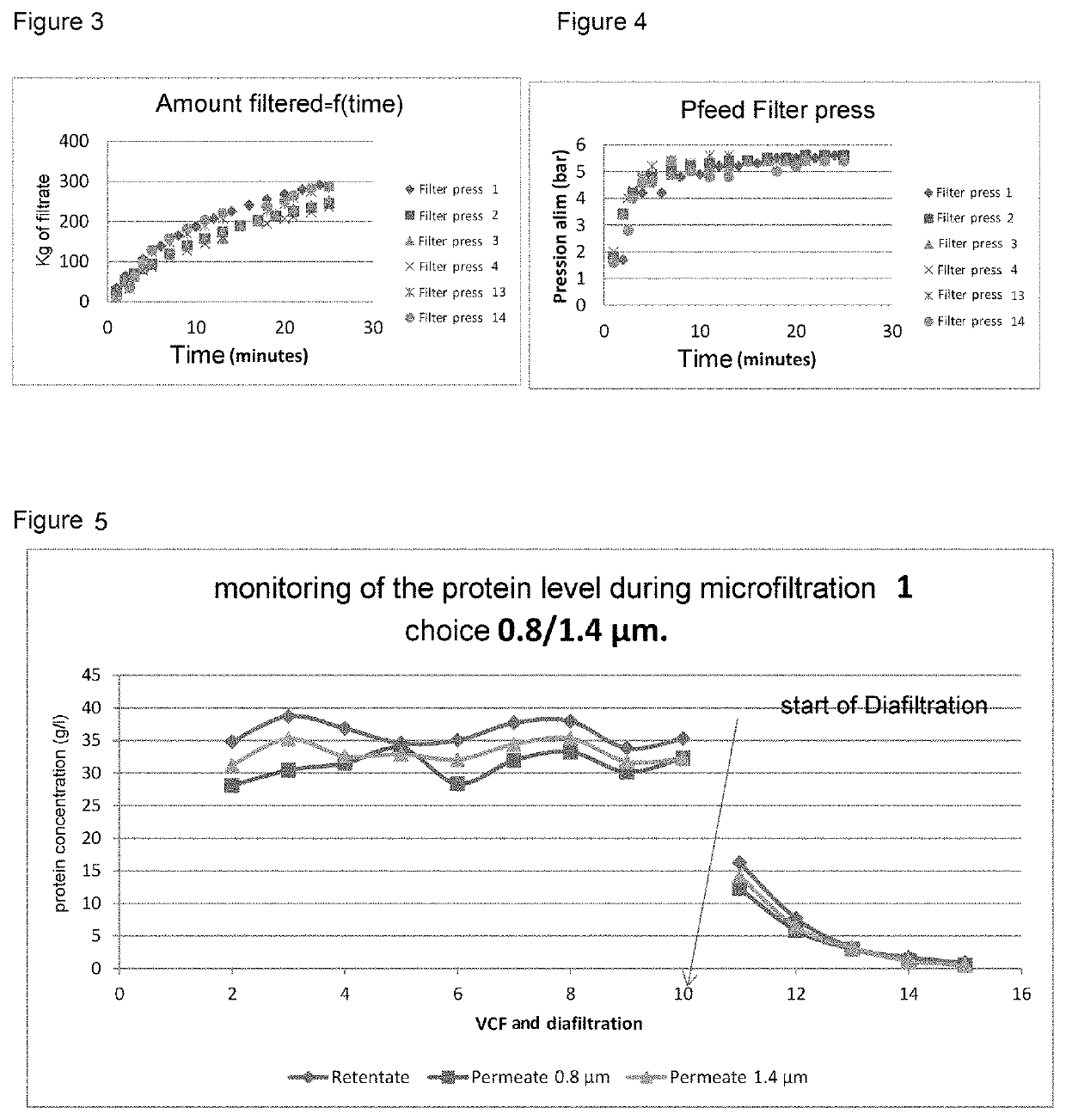Separation of enzymes from trichoderma reesei by filter press and tangential filtration on a ceramic membrane
a technology of ceramic membrane and trichoderma reesei, which is applied in the field of separation of enzymes from fungi, can solve the problems of low production cost, heat resistance, and inability to separate cellulases, and achieve the effect of increasing the cost of organic membranes (approximately 10 times more expensive)
- Summary
- Abstract
- Description
- Claims
- Application Information
AI Technical Summary
Benefits of technology
Problems solved by technology
Method used
Image
Examples
examples
[0112]Example 1 demonstrates the poor enzyme permeability obtained with microfiltration with organic membranes. This problem is solved in example 2 with the use of mineral membranes. Example 3 compares two series carried out either with a conventional separation process or with the process described in the patent. Example 4 presents the complete balance of a separation on a large volume.
example no.1
Example No. 1: Tests of Microfiltration on an Organic Membrane (Comparative)
[0113]The culture medium to be treated resulting from the production phase has the following composition:[0114]40 g / l of proteins[0115]20 g / l of biomass (fungus T. reesei).
[0116]After having undergone separation via a filter press, the filtrate is tested on various microfiltration membranes.
[0117]FIGS. 1 and 2 present the results of the laboratory tests carried out with organic membranes having porosities ranging from 0.1 to 0.8 μm: membranes MFG1: cutoff threshold of 0.1 μm (polysulfone), MFG2: 0.2 μm (polysulfone), MFG8: 0.8 μm (polysulfone), MFP5: 0.5 μm (fluoro).
[0118]VCF represents the volumetric concentration factor.
[0119]The low permeability of these membranes to enzymes is noted.
[0120]The permeability is defined as being the ratio between the concentration of the enzymes in the permeate (which passes through the membrane) and the concentration in the retentate (which remains).
example 2
Microfiltration on a Ceramic Membrane
[0121]The same filtrate is used with 4 membranes with the cutoff thresholds of 0.14, 0.45, 0.8 and 1.4 μm.
[0122]The method used was to test 4 cutoff thresholds in parallel for each filtration. The tool used is a pilot filtration unit which makes it possible to receive 4 different membranes in one and the same casing. It has one permeate outlet per membrane and a single retentate loop. It thus makes it possible to study, in parallel, the variations in permeate flow rates for 4 membranes and to produce samples.
[0123]The measurements of the enzyme concentrations reveal disparities.
[0124]The filtrate resulting from the filter press has an enzyme concentration of 38.2 g / l. The final retentate was quantitatively determined at 44.3 g / l.
[0125]There was thus a slight concentration of the retentate, which suggests a retention by one or more membranes. The enzyme concentrations of the 4 permeates are the following:
Cutoff threshold (μm)0.140.450.81.4Enzyme c...
PUM
| Property | Measurement | Unit |
|---|---|---|
| Temperature | aaaaa | aaaaa |
| Temperature | aaaaa | aaaaa |
| Length | aaaaa | aaaaa |
Abstract
Description
Claims
Application Information
 Login to View More
Login to View More - R&D
- Intellectual Property
- Life Sciences
- Materials
- Tech Scout
- Unparalleled Data Quality
- Higher Quality Content
- 60% Fewer Hallucinations
Browse by: Latest US Patents, China's latest patents, Technical Efficacy Thesaurus, Application Domain, Technology Topic, Popular Technical Reports.
© 2025 PatSnap. All rights reserved.Legal|Privacy policy|Modern Slavery Act Transparency Statement|Sitemap|About US| Contact US: help@patsnap.com


